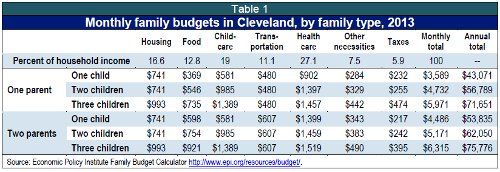So, here's the point of the previous three posts:
The Clevelanders whose minimal average paychecks are discussed in these posts are not "the poor", as this term is generally used. They aren't unemployed, or stuck in part-time or seasonal work. They aren't "on welfare". They're not living on disability checks. For the most part, they're not homeless.
Cleveland has plenty of residents in each of these situations (except for "on welfare", which doesn't really exist any more). But that's not who we're talking about here.
No, we're talking here about the city's success stories. We're talking about the people who got the job -- those who went to work and collected a paycheck for at least 35 hours, for at least 50 weeks out of 52.
According to the Census, only about half of the city's adults who are "in the labor force" during any given year manage to be "full-time, year-round employed". In 2012, according to the Census, about 94,000 Clevelanders achieved this elite status.
And half of them earned less than $32,000 (pre-tax) for that year of work.
This was the case even for those in the so-called "good job" sectors -- manufacturing (median less than $34,000 a year) and "health and social" (median barely $31,000). In the "not such good job" sectors that employ one out of six of the city's fulltime workers, the picture was predictably even bleaker: half of the 8,000 Cleveland residents with full-time retail jobs made less than $25,300, and half of our 6,400 neighbors who worked full-time in "accommodation and food services" were paid less than $21,800.
And there's a significant swath of Cleveland neighborhoods where the economic winners -- the neighbors who got up and went to work eight hours a day, five days a week -- had only a 50-50 chance of making $30,000, or even $25,000, for their efforts.
Of course there's nothing obscure about working people in poverty. Just last week, talking-head discussion attached to the War on Poverty Anniversary was all about the "new poverty" driven by declining real wages in much of the U.S. labor market. (See the quote from Peter Edelman in the Plain Dealer story. And here's Paul Krugman.) To the extent that organized labor has gotten any good press at all in the past year, it's come from McDonald's employees agitating for a living wage of $15 an hour. Big minimum wage increases are suddenly on the public agenda, from SeaTac and the District of Columbia to the White House.
But there's a strange disconnect between this big national discussion of low-wage employment -- a discussion which I'm sure is followed closely by many of Cleveland's "progressive" political and community leaders -- and our local conversations regarding economic and community development priorities. Cleveland's public agencies, nonprofits and foundations pursue our economic development, neighborhood development and even workforce development activities as if the actual money earned by our community's working citizens is strategically irrelevant.
"Jobs" is everybody's metric. "Median full-time, year-round earnings" of the people who get those jobs is nobody's.
Not to put too fine a point on it, this is weird. After all, for community impact, it's the money that matters.
When a single parent graduates from workforce training into an ED-supported job that will never pay more than $13 or $14 an hour -- thus becoming a "success statistic" for the workforce agency and the City or County ED office, and maybe for her local community development organization as well -- what's the actual community benefit? With maybe $2,000 a month in her hands after taxes, how much is she possibly going to save? To invest in a home (without entering rent-to-own hell)? In her kids' education? In her own advancement? How much discretionary spending will she represent to a mainstream retailer who's calculating the return on a potential neighborhood investment?
This city has neighborhoods where this is the new normal for working residents. We spend millions of public and philanthropic dollars to subsidize "creation" of this kind of job; to help people get this kind of job; and to help people with this kind of earned income pick up some Federal tax credit money, get their kids on Medicaid, learn to manage their limited incomes and establish credit so they can get in debt, and even become "homeowners" (with little or no actual equity).
But we invest almost nothing, either in funding or in other kinds of community capital, to help our many residents who are already working full-time, year-round for very little money to earn more.
What form could that help take? I'll explore that in some future posts.
P.S. Policy Matters, in Getting By in Ohio: The 2013 Basic Family Budget, used the Economic Policy Institute's Family Budget Calculator to create this chart of family living costs in Cleveland. (Click the graphic to see it full-sized.)
$43,000 a year for a single adult with one child. Sounds about right to me.
